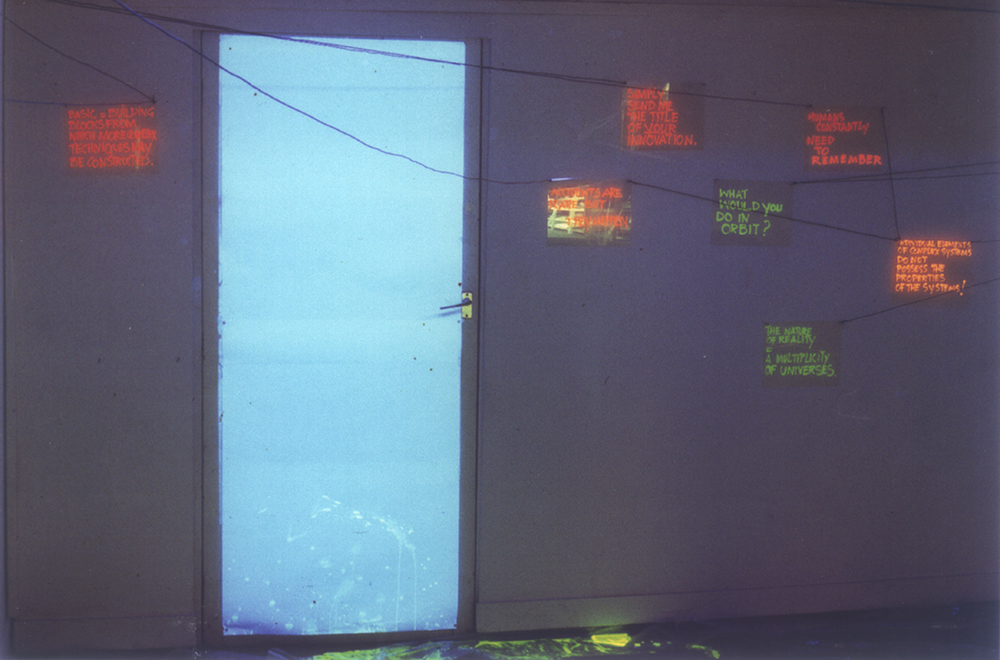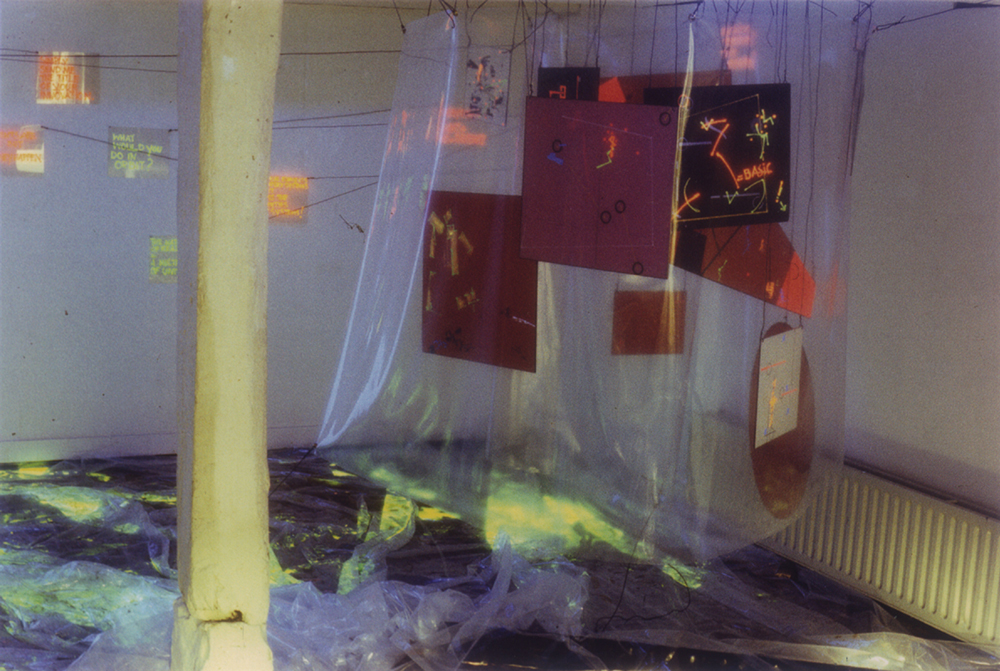= Basic
in Art Something, Amsterdam, Netherlands, from 23 Aug 1980 to 13 Sep 1980




Ik leg dun plastic op een vloer en giet er geelfluorescerend water op, het is licht radioactief (niet ongevaarlijk).
Ik hang 21 teksten op de muren op verschillende hoogten, fluorescerend op transparante plexi, duidelijk in hetgeen ze bedoelen. De teksten worden verbonden door dunne, zwarte elektriciteitsdraden. De combinaties worden gemaakt er plaatse (mijn gedachten en interesses van dat moment.)
Er hangt een spiraal, gevormd door een groot dik plastic, daarin 17 plexi-werken met onregelmatige grootte en zowel nieuwe als oudere vormen erop. Het is mogelijk de spiraal binnen te wandelen, maar niet eruit.
Het is noodzakelijk om door het water te lopen, en moeilijk om iets te zien doorheen de dikke plastic.
De verlichting gebeurd door 4 black lights en 1 TL onder het plastic.
Op de opening wordt verstorende, doch esthetisch aanvaardbare muziek gedraaid.
Het geheel geeft het gevoel binnen een krachtveld te lopen, de spanning is ondraaglijk.
Een idee binnengaan.
I lay thin plastic on the floor and pour yellow-fluorescent water on it, it is slightly radio-active (not harmless). I hang 21 texts on the wall on different heights, fluorescent on transparent plexi, clear in what they stand for. The texts are combined by the use of thin, black electricity- wires. The combinations are made on the spot (my thoughts and interests of that very moment).
There hangs a spiral for formed by a large thick sheet of plastic, in there 17 plexi-works of irregular shapes, and new as well as older images on them. It is quite possible to walk in but not out. It is necessary to walk through the water, and difficult to see a thing through the thick plastic.
The lights are 4 black lights and 1 TL under the plastic.
On the opening-night disturbing but aesthetically acceptable music is played.
The whole has a feeling of walking into a power-field.
To enter an idea.
Een nieuwe manier van waarnemen kan slechts het nieuwe waarnemen. Hiervoor gebruik ik tekens die
- de toekomst als inhoud hebben
- op zichzelf staan
- de termen vorm en kleur als afzonderlijke eenheden vervangen.
Dit is het begin van een onderzoek naar informatie.
In hoeverre wetenschap onze toekomst heeft beïnvloed -- en in de toekomst?
In hoeverre logica hierin een rol gaat spelen.
toekomst kunst
=
logica wetenschap
Praktische aanwendingen van “logica” leidt tot tijdwinning door overslaan van voorspelbare processen.
Het is zeer positief dingen te zeggen die men nooit gedacht zou kunnen hebben d.w.z. dat de evolutie van uw gedachtegang - buiten u om verder gaat zonder bewustzijn of persoonlijke interventie - bepaalde omstandigheden worden bepalend voor onmiddellijke gedachtegang.
Een beeld roept slechts 1x een bepaalde gedachte op -- soms roept een beeld de herinnering aan die gedachten op.
Associaties op 1 tijdstip -- in verband met een beeld zijn éénmalig.
Alles moet zo gemaakt worden dat het vervolg erin zit -- en wel zo dat het nooit af is.
A new manner of perceiving can only perceive the new. Therefore I use signs who
- have the future as content
- present new ways of thinking
- stand on their own
- replace the terms form and colour as separate units.
This is the start of an investigation towards information.
In how far science has influenced our future -- and in the future?
In how far logics will play a role in this.
future art
=
logics science
Practical use of “logics” leads to gain of time through passing over predictable processes.
It is very positive to say things which one never could have thought. This means that the evolution of your way of thinking - goes on outside you without consciousness or personal intervention - certain circumstances become defining for immediate train of thought.
An image only calls 1x certain thought -- sometimes an image calls the memory to that thought.
Associations on 1 bit of time -- in relation to an image are unique.
Everything has to be made so that the continuance is in it -- and so that it is never finished.
0 works and 0 articles (until now)
8786 views